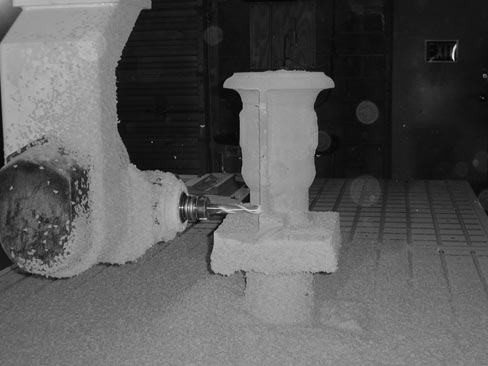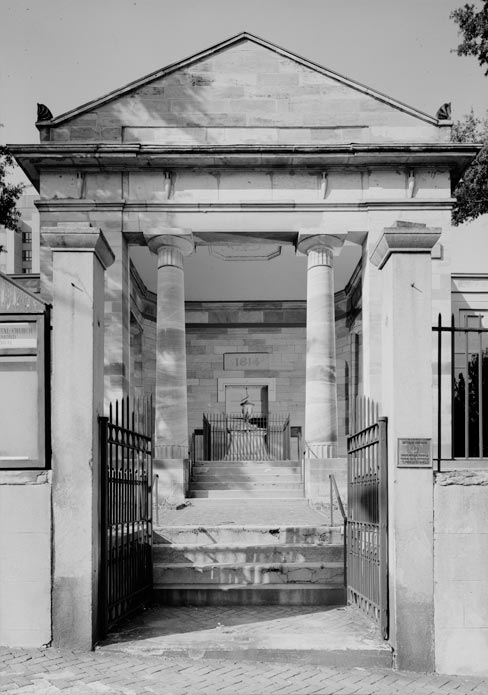Research Report
The Restoration of Monumental Church in Richmond, Virginia
by Amy Swartz
Monumental Church on East Broad Street in Richmond, Virginia, marks the site of one of the city's worst disasters. A catastrophic fire during a holiday performance at the Richmond Theatre on the site on December 26, 1811, claimed the lives of 72 people, including the newly elected governor of Virginia, George W. Smith. At the time, Richmond had a population of approximately 5,000 people, and the death of 72 residents affected almost every family in the city. While many important and prominent citizens perished in the blaze, the victims represented a cross section of society. The fire killed governor and slave, young and old. In a final gesture of humanity, all were buried together in one common grave on the site.
The theater site became hallowed ground as the city coped with the tragedy. U.S. Supreme Court Chief Justice John Marshall led a committee to raise funds for a memorial on the site of the mass grave. During the fundraising process it was decided that a much-needed church should be built in conjunction with the proposed memorial. A "monumental church" eventually rose out of the theater's ashes and served an Episcopalian congregation until its de-consecration in 1965.
Despite the recognition of Monumental Church's place among the nation's most important historic structures, the building was in dire need of restoration at the close of the 20th century. In October 2002, a Save America's Treasures (SAT) grant from the National Park Service launched a multi-million dollar restoration campaign to preserve the crumbling fabric of this national historic landmark and memorial to the victims of the devastating fire.
History of Monumental Church
The designer of Monumental Church, Robert Mills, maintained that he was America's first native born, trained architect. His architectural instruction began in Charleston, South Carolina, but his knowledge deepened under the tutelage of James Hoban and Thomas Jefferson once he moved to Washington, DC. Jefferson encouraged Mills's architectural endeavors, giving him unlimited access to his library and introducing him to the man who became his mentor, Benjamin Henry Latrobe. Latrobe's sponsorship lasted until 1811, when Mills entered the design competition for a memorial to the victims of the Richmond Theatre fire, which Latrobe had also entered. Mills's design for a "monumental church" and memorial was selected.
Mindful of the desire for a combined memorial and church, Mills created a monumental porch as a vestibule and memorial space with an octagonal shaped church behind, integrating the two functions. Work began in 1812 and lasted for two years. Monumental Church was built around and over the crypt that can be seen in the basement of the structure. The first Episcopal service was held on May 4, 1814.
The most elaborate and only surviving of the five domed octagonal buildings designed by Mills, Monumental Church is a national architectural treasure. Mills strove to innovate, not imitate, and often composed on a grand scale. His inventive style melded many different motifs from antiquity, including Egyptian, Roman, and Greek, into a new American architectural vocabulary that began at Monumental Church. Mills's design for the memorial church goes beyond the influences of Latrobe and demonstrates his own unique expression of architecture during the nation's infancy.
Restoration Work
John Milner Associates, Inc., the firm hired to develop a conservation plan for Monumental Church, established the guidelines for the building's complete restoration. The project consists of four distinct phases. Phase I, which ran from June 2003 to December of that year, focused on the building envelope and weatherproofing of the exterior to prevent leaks and solve a moisture problem that threatened the structure. Phase II focused on mechanical systems, specifically air conditioning and a dehumidification system to provide the necessary regulated environment inside the building.
The mechanical systems put in place in Phase II also will ensure the sustainability of the work to be carried out in the interior during Phase III, which includes the restoration of the plaster, wood, and painted surfaces. The final phase involves the restoration of the grounds, the surrounding exterior brick walls, and cast iron fencing. This phase also involves site drainage improvements and the construction of outside access to the basement crypt.
Restoration of the Monument
The restoration project also had to include the memorial's signature marble funerary urn.(Figure 1) In 1999, the urn in the center of the memorial, weakened by decades of pollution and weather damage, broke off its base. A team of architectural conservators called in to examine the monument recommended replacing the urn with a replica to minimize further damage to the original.
The conservation team, working with Direct Dimensions, Inc., a laser scanning, digital modeling, and reverse engineering company, began by documenting the monument with a precise seven axis laser scanner. They used information from their scans and historic photographs to analyze areas where sculptural details had been lost and digitally recreated the monument.
The innovative imaging technologies used in this project are at the forefront of conservation and preservation technology. The process combines data acquisition technologies derived from aerospace engineering with established (but not widely known) milling technologies to reconstruct complex architectural and sculptural details in a timely and cost effective manner.
Next, skilled stoneworkers used the virtual reconstruction to fabricate the final three-dimensional replica of the urn out of marble, employing a combination of computer-based milling software and hand sculpting equipment. The replica was installed in 2005, and the original was dismantled and safely stored for future conservation and indoor display.(Figure 2)
 |
Figure 2. This image shows the process by which the funerary urn was replicated in ren board, a "poured" wood material. The ren board urn was an exact copy of the original. (Courtesy of the author.) |
Since the 1980s, outdoor marble sculptures have been eroding at an accelerated pace. Atmospheric pollutants attack the binding elements in the marble, causing it to disaggregate. The innovative technologies used for examining and remaking the monument have the potential to transform historic preservation practice, protecting original artifacts and digitally restoring them for future generations to study, enjoy, and appreciate. To that end, the funerary urn modeling has already served as a prototype for other endeavors.
Conclusion
To date, Historic Richmond Foundation has completed two of the four phases prescribed by the conservation and restoration plan, plus caring for the funerary monument itself. Plans are underway to continue the work laid out in Phases III and IV. When complete, Monumental Church will be available to tourists, students, and scholars; the facilities will once again host lectures, plays, concerts, and other programs absent from the site since the tragic fire. The auditorium-style seating in the church combines the architectural traditions of the evangelical and educational, further integrating past and present use of Monumental Church.
About the Author
Amy Swartz is the director of preservation services at Historic Richmond Foundation in Richmond, Virginia.
Notes
1. The Robert Mills designed building became a national historic landmark in 1971. Historic Richmond Foundation has owned the building since 1983.
2. John M. Bryan, America's First Architect Robert Mills (NY: Princeton Architectural Press, 2001), xi, 97-105.
3. The others were Circular Church, Charleston (1804), Sansom Street Church, Philadelphia (1808), Octagonal Church, Philadelphia (1813), and First Baptist Church, Baltimore (1816).

